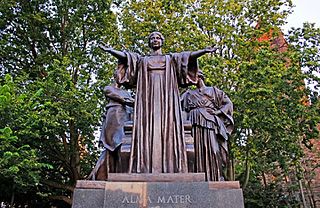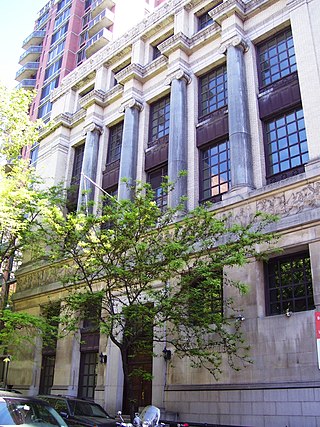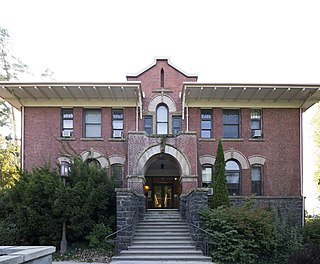
Illinois Institute of Technology, commonly referred to as Illinois Tech and IIT, is a private research university in Chicago, Illinois, United States. Tracing its history to 1890, the present name was adopted upon the merger of the Armour Institute and Lewis Institute in 1940. The university has programs in architecture, business, communications, design, engineering, industrial technology, information technology, law, psychology, and science. It is classified among "R2: Doctoral Universities – High research activity".

Georgian Court University is a private Roman Catholic university in Lakewood Township, New Jersey. Founded in 1908 by the Sisters of Mercy, the university has more than 1,600 undergraduates and nearly 600 graduate students.

Pratt Institute is a private university with its main campus in Brooklyn, New York. It has a satellite campus in Manhattan and an extension campus in Utica, New York at the Munson-Williams-Proctor Arts Institute. The school was founded in 1887 with programs primarily in engineering, architecture, and fine arts. Comprising six schools, the institute is primarily known for its programs in architecture, graphic design, interior design, and industrial design.

West Liberty University (WLU) is a public university in West Liberty, West Virginia, United States. Located in the state's Northern Panhandle, it was established as an academy in 1837 and is the oldest university in West Virginia. It offers more than 70 undergraduate majors and graduate programs and had an enrollment of approximately 2,500 students in 2022.

The University of Illinois Urbana-Champaign is an academic research institution that is the flagship campus of the University of Illinois System. Since its founding in 1867, it has resided and expanded between the twin cities of Champaign and Urbana in the State of Illinois. Some portions are in Urbana Township.

Kathryn Chicone Ustler Hall is a historic building on the campus of the University of Florida (UF) in Gainesville, Florida. It was designed by William Augustus Edwards in the Collegiate Gothic style and opened in 1919 as the University Gymnasium. In that capacity, the building was the first home of the Florida Gators men's basketball team, and it continued to serve as the home court for most of the university's indoor sports programs until the Florida Gymnasium opened in the late 1940s. The university became co-educational at about the same time, and the building was rechristened the Women's Gymnasium and was repurposed as a recreation center for the school's many new female students. On June 27, 1979, it was added to the U.S. National Register of Historic Places.

The campus of the University of Oregon is located in Eugene, Oregon, and includes some 80 buildings and facilities, including athletics facilities such as Hayward Field, which was the site of the 2008 Olympic Track and Field Trials, and McArthur Court, and off-campus sites such as nearby Autzen Stadium and the Riverfront Research Park. An online guide published by the University of Oregon Libraries, Architecture of the University of Oregon, describes campus buildings and provides timelines of key architectural events linked with campus history.

The New York School of Applied Design for Women, established in 1892 by Ellen Dunlap Hopkins, was an early design school for women in New York City. The 1908 New York School of Applied Design building was designed by Harvey Wiley Corbett and is now landmarked.

The George W. Smith House is a home in the Chicago suburb of Oak Park, Illinois, United States designed by American architect Frank Lloyd Wright in 1895. It was constructed in 1898 and occupied by a Marshall Field & Company salesman. The design elements were employed a decade later when Wright designed the Unity Temple in Oak Park. The house is listed as a contributing property to the Ridgeland-Oak Park Historic District which joined the National Register of Historic Places in December 1983.

Ambler's Texaco Gas Station, also known as Becker's Marathon Gas Station, is a historic filling station located at the intersection of Old U.S. Route 66 and Illinois Route 17 in the village of Dwight, Illinois, United States. The station has been identified as the longest operating gas station along Route 66; it dispensed fuel for 66 continuous years until 1999. The station is a good example of a domestic style gas station and derives its most common names from ownership stints by two different men. North of the station is an extant outbuilding that once operated as a commercial icehouse. Ambler's was the subject of major restoration work from 2005 to 2007, and reopened as a Route 66 visitor center in May 2007. It was added to the U.S. National Register of Historic Places in 2001.

The Athenæum, originally named Das Deutsche Haus, is the most ornate and best-preserved building affiliated with the German American community of Indianapolis. Once used as a German American Turnverein and clubhouse, it currently houses many groups, organizations, and businesses. The Athenæum is located across Massachusetts Avenue from the Old National Centre. It was placed on the National Register of Historic Places on February 21, 1973. On October 31, 2016, it was named the 41st National Historic Landmark in Indiana.
The University of Arkansas Campus Historic District is a historic district that was listed on the National Register of Historic Places on September 23, 2009. The district covers the historic core of the University of Arkansas campus, including 25 buildings.

The Veterans Memorial Elementary School, also known as Veterans Memorial STEM Academy, at 1200 Locust St., is a public elementary school in Reno, Nevada, operated by the Washoe County School District. It occupies a historic Moderne-style building dating from 1949 that was designed by Nevada architect Russell Mills. It was listed on the National Register of Historic Places in 1995. It was deemed significant "for its role in the local history of education" and "for its Art Deco/Moderne style of architecture by a prominent local architect, Russell Mills."

Gerlinger Hall is a historic building on the University of Oregon campus in Eugene, Oregon as part of the Women's Memorial Quadrangle. For the first time, enough women were attending the University that they could occupy their own full quadrangle.

Carol Ross Barney is an American architect and the founder and Design Principal of Ross Barney Architects. She is the 2023 winner of the AIA Gold Medal. She became the first woman to design a federal building when commissioned as architect for the Oklahoma City Federal Building, which replaced the bombed Alfred P. Murrah Federal Building. Ross Barney's other projects include the JRC Synagogue, James I Swenson Civil Engineering Building, the CTA Morgan Street Station, and the Chicago Riverwalk.

The Main Library is a historic library on the campus of the University of Illinois Urbana-Champaign in Urbana, Illinois. Built in 1924, the library was the third built for the school; it replaced Altgeld Hall, which had become too small for the university's collections. Architect Charles A. Platt designed the Georgian Revival building, one of several on the campus which he designed in the style. The building houses several area libraries, as well as the University Archives and the Rare Book & Manuscript Library. The Main Library is the symbolic face of the University Library, which has the second largest university library collection in the United States.

Louise Freer Hall, also known as the Women's Gymnasium, is a historic building on the campus of the University of Illinois Urbana-Champaign. Built in 1930, it was the last of the university's buildings designed by Charles A. Platt, who was responsible for the university's overall plan. Like most of Platt's designs for the university, the building has a Georgian Revival plan. The gymnasium originally provided expanded facilities for the women's physical education department, which had outgrown its space in the Woman's Building. The new gymnasium's facilities included two general-purpose spaces, several specialized facilities, and a physical education laboratory. Louise Freer, the women's physical education director for whom the building was later renamed, added a lounge area in 1932 to provide a social space in the building. The building is still used as a gymnasium and hosts intramural sporting events and physical education classes.

The University of Idaho Gymnasium and Armory is a historic building in the northwest United States, on the campus of the University of Idaho in Moscow, Idaho. On the southwest corner of Campus Drive and University Avenue, just northwest of the Administration Building, it was built as a gym and armory in 1903.

The Berwyn Health Center is a historic public health clinic at 6600 W. 26th Street in Berwyn, Illinois. Built in 1938–39, the building provided an expanded home for the city's health department. In addition to providing healthcare and leading vaccination efforts, the department was responsible for food inspection and Great Depression relief programs in the 1930s, and the new building gave it the space and resources it needed to accomplish its many duties. Along with the city's municipal building and post office, the health center was one of three buildings built in Berwyn with Public Works Administration funds in a three-year period. Architect Vladimir J. Novak, a Berwyn resident, designed the building using elements of Art Deco and Moderne architecture. Both styles were commonly used, often together, in PWA buildings; in the case of the health center, its Art Deco influence is visible in its geometric massing, while its horizontal banding is a typical Moderne feature. The building remains in use as a health clinic and government office.




















